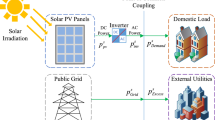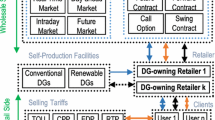Abstract
This paper deals with the problem of determining the optimal size of a residential grid-connected photovoltaic system to meet a certain \(\mathrm{CO }_2\) reduction target at a minimum cost. Ren et al. proposed a novel approach using a simple linear programming that minimizes the total energy costs for residential buildings in Japan. However, their approach is based on a specific net tariff system that was used in Japan until October 2009, and it is not applicable to Japan’s current net tariff system. We propose a modified approach for Japan’s current tariff system. The mathematical formulation is general in the sense that it includes formulations for other tariff systems as special cases. Therefore, the approach is applicable not only to the Japanese system but also to other tariff systems (e.g., gross feed-in tariff system). We further extend this approach by using a robust optimization technique to cope with the uncertainty in photovoltaic power generation caused by weather variability. Numerical experiments show the minimum size requirements of solar photovoltaic systems for meeting \(\mathrm{CO }_2\) reduction targets and their economic costs in nominal and robust cases.



















Similar content being viewed by others

Notes
Robust optimization only requires mild assumptions for uncertain data such as bounded support and does not need the probability distribution. To relate an ellipsoidal uncertainty set to a confidence ellipsoid, however, we here assume the normal distribution.
References
Ben-Tal, A., Nemirovski, A.: Robust convex optimization. Math. Oper. Res. 23(4), 769–805 (1998)
Ben-Tal, A., Nemirovski, A.: Robust solutions of uncertain linear programs. Oper. Res. Lett. 25(1), 1–13 (1999)
Ben-Tal, A., Goryashko, A., Guslitzer, E., Nemirovski, A.: Adjustable robust solutions of uncertain linear programs. Math. Program. 99(2), 351–376 (2004)
Bernal-Agustin, J.L., Dufo-Lopez, R.: Economical and environmental analysis of grid connected photovoltaic systems in Spain. Renew. Energy 31, 1107–1128 (2006)
Elkamel, A., Hashim, H., Douglas, P.L., Croiset, E.: Optimization of energy usage for fleet-wide power generating system under carbon mitigation options. AIChE J. 55(12), 3168–3190 (2009)
Gong, X., Kulkarni, M.: Design optimization of a large scale rooftop photovoltaic system. Solar Energy 78, 362–374 (2005)
Guslitzer, E.: Uncertainty-immunized solutions in linear programming. MS Thesis, Israel Institute of Technology (2002)
Hashim, H., Douglas, P., Elkamel, A., Croiset, E.: Optimization model for energy planning with CO$_{2}$ emission considerations. Ind. Eng. Chem. Res. 44, 879–890 (2005)
Hernandez, J.C., Vidal, P.G., Almonacid, G.: Photovoltaic in grid-connected buildings. Renew. Energy 15, 562–565 (1998)
Japanese Industrial Standards Committee, Estimation method of generating electric energy by PV power system, JIS C 8907 (2005)
Japan Meteorological Agency. http://www.jma.go.jp/jma/index.html
Kajiyama, K., Okajima, K., Uchiyama, Y.: Energy and environmental analysis of batteries for electric load leveling using LCA method. J. Life Cycle Assess. 2(4), 379–385 (2006, in Japanese)
Linares, P., Romero, C.: Aggregation of preferences in an environmental economics context: a goal-programming approach. Omega 30, 89–95 (2002)
Muis, Z.A., Hashim, H., Manan, Z.A., Taha, F.M., Douglas, P.L.: Optimal planning of renewable energy-integrated electricity generation schemes with CO$_{2}$ reduction target. Renew. Energy 35, 2562–2570 (2010)
Nakano, S., Hayami, H., Nakamura, M., Suzuki, M.: The Input–Output Table for Environmental Analysis and its Applications. Keio University Press, Tokyo (2008, in Japanese)
New Energy and Industrial Technology Development Organization (NEDO). http://www.nedo.go.jp/library/shiryou_application.html
Rebennack, S., Flach, B., Pereira, M.V.F., Pardalos, P.M.: Stochastic hydro-thermal scheduling under CO\(_{2}\) emissions constraints. IEEE Trans. Power Syst. 27, 58–68 (2012)
Ren, H., Gao, W., Ruan, Y.: Economic optimization and sensitivity analysis of photovoltaic system in residential buildings. Renew. Energy 34, 883–889 (2009)
Sturm, J.F.: Using SeDuMi 1.02, a matlab toolbox for optimization over symmetric cones. Optim. Methods Softw. 11–12(1–4), 625–653 (1999)
Takeda, A., Taguchi, S., Tutuncu, R.: Adjustable robust optimization models for a nonlinear two-period system. J. Optim. Theory Appl. 136(2), 275–295 (2008)
Yamaguchi, M., Iga, A., Ishihara, K., Wada, D., Yoshii, K., Sueda, O.: Study for merit of battery combined photovoltaic generation system for residential house. Trans. IEE Japan 123-B(3), 402–411 (2003, in Japanese)
Author information
Authors and Affiliations
Corresponding author
Rights and permissions
About this article
Cite this article
Okido, S., Takeda, A. Economic and environmental analysis of photovoltaic energy systems via robust optimization. Energy Syst 4, 239–266 (2013). https://doi.org/10.1007/s12667-013-0077-1
Received:
Accepted:
Published:
Issue Date:
DOI: https://doi.org/10.1007/s12667-013-0077-1



